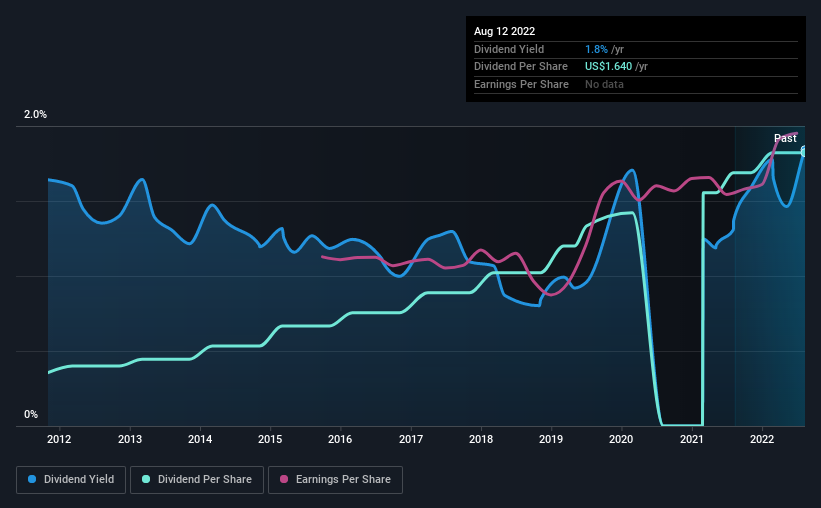Be Sure To Check Out U.S. Physical Therapy, Inc. (NYSE:USPH) Before It Goes Ex-Dividend
Readers hoping to buy U.S. Physical Therapy, Inc. (NYSE:USPH) for its dividend will need to make their move shortly, as the stock is about to trade ex-dividend. The ex-dividend date is one business day before a company's record date, which is the date on which the company determines which shareholders are entitled to receive a dividend. The ex-dividend date is of consequence because whenever a stock is bought or sold, the trade takes at least two business day to settle. Accordingly, U.S. Physical Therapy investors that purchase the stock on or after the 17th of August will not receive the dividend, which will be paid on the 16th of September.
The company's next dividend payment will be US$0.41 per share, and in the last 12 months, the company paid a total of US$1.64 per share. Based on the last year's worth of payments, U.S. Physical Therapy has a trailing yield of 1.8% on the current stock price of $89.04. Dividends are an important source of income to many shareholders, but the health of the business is crucial to maintaining those dividends. We need to see whether the dividend is covered by earnings and if it's growing.
View our latest analysis for U.S. Physical Therapy
Dividends are usually paid out of company profits, so if a company pays out more than it earned then its dividend is usually at greater risk of being cut. U.S. Physical Therapy paid out 54% of its earnings to investors last year, a normal payout level for most businesses. A useful secondary check can be to evaluate whether U.S. Physical Therapy generated enough free cash flow to afford its dividend. Fortunately, it paid out only 35% of its free cash flow in the past year.
It's positive to see that U.S. Physical Therapy's dividend is covered by both profits and cash flow, since this is generally a sign that the dividend is sustainable, and a lower payout ratio usually suggests a greater margin of safety before the dividend gets cut.
Click here to see the company's payout ratio, plus analyst estimates of its future dividends.
Have Earnings And Dividends Been Growing?
Companies with consistently growing earnings per share generally make the best dividend stocks, as they usually find it easier to grow dividends per share. If earnings fall far enough, the company could be forced to cut its dividend. For this reason, we're glad to see U.S. Physical Therapy's earnings per share have risen 12% per annum over the last five years. U.S. Physical Therapy is paying out a bit over half its earnings, which suggests the company is striking a balance between reinvesting in growth, and paying dividends. Given the quick rate of earnings per share growth and current level of payout, there may be a chance of further dividend increases in the future.
The main way most investors will assess a company's dividend prospects is by checking the historical rate of dividend growth. Since the start of our data, 10 years ago, U.S. Physical Therapy has lifted its dividend by approximately 18% a year on average. It's exciting to see that both earnings and dividends per share have grown rapidly over the past few years.
Final Takeaway
Is U.S. Physical Therapy worth buying for its dividend? We like U.S. Physical Therapy's growing earnings per share and the fact that - while its payout ratio is around average - it paid out a lower percentage of its cash flow. There's a lot to like about U.S. Physical Therapy, and we would prioritise taking a closer look at it.
So while U.S. Physical Therapy looks good from a dividend perspective, it's always worthwhile being up to date with the risks involved in this stock. In terms of investment risks, we've identified 2 warning signs with U.S. Physical Therapy and understanding them should be part of your investment process.
A common investing mistake is buying the first interesting stock you see. Here you can find a full list of high-yield dividend stocks.
Have feedback on this article? Concerned about the content? Get in touch with us directly. Alternatively, email editorial-team (at) simplywallst.com.
This article by Simply Wall St is general in nature. We provide commentary based on historical data and analyst forecasts only using an unbiased methodology and our articles are not intended to be financial advice. It does not constitute a recommendation to buy or sell any stock, and does not take account of your objectives, or your financial situation. We aim to bring you long-term focused analysis driven by fundamental data. Note that our analysis may not factor in the latest price-sensitive company announcements or qualitative material. Simply Wall St has no position in any stocks mentioned.
Join A Paid User Research Session
You’ll receive a US$30 Amazon Gift card for 1 hour of your time while helping us build better investing tools for the individual investors like yourself. Sign up here

 Yahoo Movies
Yahoo Movies 

